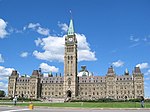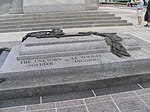Bytown
Former municipalities now in OttawaHistory of OttawaPopulated places established in 1850
Bytown is the former name of Ottawa, Ontario, Canada. It was founded on September 26, 1826, incorporated as a town on January 1, 1850, and superseded by the incorporation of the City of Ottawa on January 1, 1855. The founding was marked by a sod turning, and a letter from Governor General Dalhousie which authorized Lieutenant Colonel John By to divide up the town into lots. Bytown came about as a result of the construction of the Rideau Canal and grew largely due to the Ottawa River timber trade. Bytown's first mayor was John Scott, elected in 1847.
Excerpt from the Wikipedia article Bytown (License: CC BY-SA 3.0, Authors).Bytown
Elgin Street, (Old) Ottawa Rideau-Vanier
Geographical coordinates (GPS) Address Nearby Places Show on map
Geographical coordinates (GPS)
| Latitude | Longitude |
|---|---|
| N 45.42451 ° | E -75.694817 ° |
Address
Pont Plaza Bridge
Elgin Street
K1P 1C7 (Old) Ottawa, Rideau-Vanier
Ontario, Canada
Open on Google Maps







